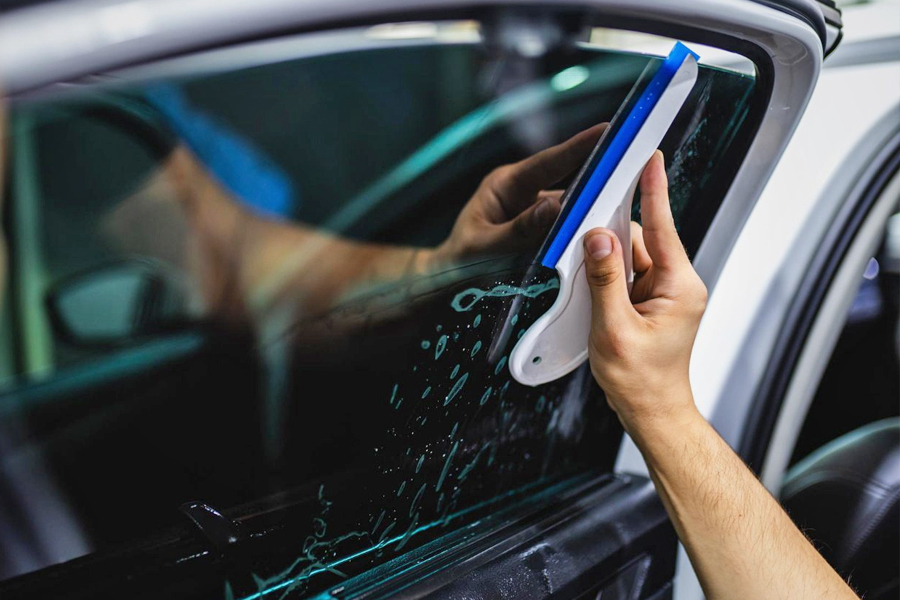Custom Vehicle Window Tinting Providers for a Streamlined and Fashionable Appearance
Custom Vehicle Window Tinting Providers for a Streamlined and Fashionable Appearance
Blog Article
Home Window Tinting Regulations and Standards: What You Required to Know Prior To Tinting Your Automobile
Before continuing with home window tinting for your vehicle, it is necessary to acquaint yourself with the diverse legislations and guidelines that govern this technique throughout different states. These laws determine the permitted levels of tint darkness, commonly determined by visible light transmission (VLT) percents, and include specific stipulations for front windshields intended at ensuring roadway safety and security.
Review of Home Window Tinting Regulations
Home window tinting laws are often subject to variation across various jurisdictions, showing neighborhood guidelines and safety and security factors to consider. These laws determine the allowable levels of tint darkness and reflectiveness on car windows, guaranteeing that motorists keep ample exposure while likewise securing against harmful UV rays and warmth.
A lot of regulations categorize home window tinting based on the Visible Light Transmission (VLT) percent, which suggests the amount of light that can go through the home window. Normally, reduced VLT percentages indicate darker colors. Legislations commonly differentiate between the front, side, and rear home windows, with more stringent restrictions put on the front windscreen to boost safety and security for both the vehicle driver and various other roadway customers.
Furthermore, some territories enforce constraints on the reflectivity of the color, protecting against too much glare that might harm presence. Exemptions to these laws may exist for people with particular clinical problems requiring additional sunlight protection. Compliance with home window tinting laws is crucial, as violations can result in fines, mandatory removal of the tint, and prospective boosts in insurance policy premiums. It is crucial for vehicle proprietors to familiarize themselves with local laws before continuing with home window tinting installations.
State-by-State Color Rules
Recognizing the certain window tinting regulations in each state is vital for vehicle owners looking for to adhere to the legislation. Each state in the U.S. has actually established its very own collection of policies controling home window tinting, which can vary significantly. These policies usually determine the allowable levels of color darkness, the kinds of home windows that can be tinted, and any type of medical exemptions that may use.
As an example, states like California have rigid restrictions on tint darkness for front windows, while others, such as New Mexico, may allow darker colors. Furthermore, particular states mandate particular presence percentages for various home windows, consisting of the windshield, front side home windows, and back home windows. It is crucial for auto owners to acquaint themselves with their state's laws to prevent prospective penalties or fines.
Additionally, some states might need an accreditation sticker to be put on colored home windows, showing conformity with state laws. Failure to stick to these laws not just takes the chance of legal repercussions yet can likewise affect security and presence while driving. For that reason, car proprietors need to carry out extensive research study or speak with regional authorities to make certain full understanding and compliance with state-by-state color guidelines.
Allowed Color Kinds and degrees
Many lorry owners may be stunned to discover that allowed tint levels and types vary extensively across various states. Each state has actually developed its very own laws concerning the acceptable darkness and reflectivity of home window tint, frequently measured by Visible Light Transmission (VLT) percents. VLT refers to the quantity of light that can go through the colored windows; thus, a lower percentage shows a darker color.

Furthermore, the sorts of color products allowed can differ, with some states forbiding mirror-like or metal surfaces. It is essential for lorry owners to familiarize themselves with their state's details regulations to ensure compliance. Non-compliance can cause penalties, necessary removal of the color, or other lawful consequences, making it crucial to understand these regulations prior to proceeding with installation.
Medical Exceptions for Tinting
While not all states offer allocations for medical exceptions concerning home window tinting, those that do identify the necessity for specific individuals to improve exposure and convenience because of medical problems. Numerous clinical problems, such as lupus, skin cancer, and look at this web-site specific eye disorders, can render individuals especially sensitive to sunshine. These people might require darker colors to protect themselves from hazardous UV rays and glare.

It is necessary to keep in mind that despite a medical exception, there may still be restrictions on the degree of tint allowed. Conformity with state regulations ensures that individuals are both protected and within legal limitations. Those considering medical exemptions ought to call their neighborhood Department of Electric motor Cars or equal authority to comprehend the procedures and needs necessary to get you could look here an exception efficiently.
Penalties for Non-Compliance
Falling short to comply with home window tinting regulations can cause significant charges, which differ by state. Police are empowered to release citations for vehicles that do not abide by the specified tinting guidelines. These fines typically include penalties, which can vary from modest amounts to a number of hundred bucks, relying on the severity of the violation and the state concerned.
In some territories, duplicated offenses might lead to rising fines or additional charges, such as necessary court looks. Non-compliance may require the elimination of prohibited tinting, often at the proprietor's expenditure. In severe instances, regular transgressors might face suspension of their lorry enrollment till conformity is attained.
In addition, insurance implications may emerge from obtaining multiple citations for home window color offenses. Insurance firms might check out such infractions as a sign of riskier behavior, potentially causing enhanced costs or problem in protection.
To stay clear of these fines, it is critical for vehicle proprietors to familiarize themselves with their neighborhood window tinting legislations and guarantee that their automobile complies (Window Tinting). This positive approach not just prevents lawful implications yet likewise advertises road safety
Final Thought

Most regulations classify home window tinting based on the Visible Light Transmission (VLT) portion, which shows the amount of light that can pass through the window. Conformity with home window tinting laws is crucial, as infractions can result in penalties, required removal of the tint, and potential increases in insurance policy costs.Understanding the details window tinting regulations in each state is essential for automobile owners seeking to conform with the regulation. These policies commonly dictate the allowed important site levels of tint darkness, the kinds of home windows that can be tinted, and any type of clinical exceptions that might apply.
For instance, states like California have strict restrictions on color darkness for front home windows, while others, such as New Mexico, may permit darker tints.
Report this page